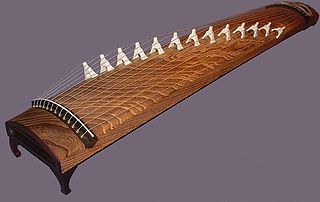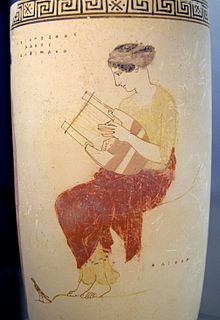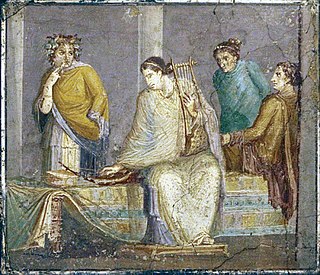
The koto is a Japanese plucked half-tube zither instrument, and the national instrument of Japan. It is derived from the Chinese zheng and se, and similar to the Mongolian yatga, the Korean gayageum and ajaeng, the Vietnamese đàn tranh, the Sundanese kacapi and the Kazakhstan jetigen. Koto are roughly 180 centimetres (71 in) in length, and made from Paulownia wood. The most common type uses 13 strings strung over movable bridges used for tuning, different pieces possibly requiring different tuning. 17-string koto are also common, and act as bass in ensembles. Koto strings are generally plucked using three fingerpicks, worn on the first three fingers of the right hand.

A lute is any plucked string instrument with a neck and a deep round back enclosing a hollow cavity, usually with a sound hole or opening in the body. It may be either fretted or unfretted.

Music is generally defined as the art of arranging sound to create some combination of form, harmony, melody, rhythm or otherwise expressive content. Exact definitions of music vary considerably around the world, though it is an aspect of all human societies, a cultural universal. While scholars agree that music is defined by a few specific elements, there is no consensus on their precise definitions. The creation of music is commonly divided into musical composition, musical improvisation, and musical performance, though the topic itself extends into academic disciplines, criticism, philosophy, and psychology. Music may be performed or improvised using a vast range of instruments, including the human voice.

The lyre is a stringed musical instrument that dates back to 1400 BC in ancient Greece. It is known for its use in Greek classical antiquity and later periods. The instrument was created and used earlier, around 2600 BC, in Egypt.

The dombra, also known as dombyra is a long-necked Kazakh, Uzbek and Bashkir lute and a musical string instrument. The dombyra shares certain characteristics with the komuz and dutar, such as its long, thin neck and oblong body shape. It is a popular instrument mostly among Turkic communities in Central Asian countries such as Kazakhstan, Uzbekistan, Tajikistan, Turkmenistan and Afghanistan.
The viola is a stringed musical instrument related to the violin. Viola also may refer to:
In music, a drone is a harmonic or monophonic effect or accompaniment where a note or chord is continuously sounded throughout most or all of a piece. A drone may also be any part of a musical instrument used to produce this effect; an archaic term for this is burden such as a "drone [pipe] of a bagpipe", the pedal point in an organ, or the lowest course of a lute. Α burden is also part of a song that is repeated at the end of each stanza, such as the chorus or refrain.
Alto is a musical term that has several possible interpretations.

The music of ancient Rome was a part of Roman culture from the earliest of times. Songs (carmen) were an integral part of almost every social occasion. The Secular Ode of Horace, for instance, was commissioned by Augustus and performed by a mixed children's choir at the Secular Games in 17 BC. Music was customary at funerals, and the tibia, a woodwind instrument, was played at sacrifices to ward off ill influences. Under the influence of ancient Greek theory, music was thought to reflect the orderliness of the cosmos, and was associated particularly with mathematics and knowledge.

Sambuca Pistoiese is a town and comune of the Province of Pistoia in the Italian region of Tuscany. The comune is in fact constituted by several different villages (frazioni), the most important of which are Pàvana at 491 metres (1,611 ft) and Treppio at 610 to 750 metres, along the valley of the Limentra di Sambuca and the Limentra orientale, respectively. The nearest railway station is that of Ponte della Venturina, 1.5 kilometres (0.9 mi) from Pàvana.

Sambuca di Sicilia is a comune (municipality) in the Province of Agrigento in the Italian region Sicily, located about 68 kilometres (42 mi) southwest of Palermo and about 89 kilometres (55 mi) northwest of Agrigento.

The Byzantine lyra or lira was a medieval bowed string musical instrument in the Byzantine Empire. In its popular form, the lyra was a pear-shaped instrument with three to five strings, held upright and played by stopping the strings from the side with fingernails. The first known depiction of the instrument is on a Byzantine ivory casket, preserved in the Bargello in Florence. Versions of the Byzantine lyra are still played throughout the former lands of the Byzantine Empire: Greece, Crete, Albania, Montenegro, Serbia, Bulgaria, North Macedonia, Croatia, Italy and Armenia.

The sambuca was an ancient stringed instrument of Asiatic origin. Many other instruments have also been called a "sambuca".
Synaulia is a team of musicians, archeologists, palaentologists and choreographers dedicated to the application of their historical research to ancient music and dance, in particular to the ancient Etruscan and Roman periods.
Greek musical instruments were grouped under the general term of "all developments from the original construction of a tortoise shell with two branching horns, having also a cross piece to which the stringser from an original three to ten or even more in the later period, like the Byzantine era". Greek musical instruments can be classified into the following categories:

Fabio Colonna was an Italian naturalist and botanist.
The magadis was an ancient Greek musical instrument. It is usually believed to be a stringed instrument similar to a psaltery or harp, though some earlier sources like the translated fragments of Posidonius discuss arguments that it may have been a woodwind. Modern scholars have mostly accepted the string instrument classification while noting that the evidence from ancient texts "falls well short of proving it." Scholars believe the word may be Lydian in origin.
Santa Lucia and similar terms may refer to:










